As a newcomer to the world of guitar, the array of chords and progressions may seem daunting.
Fortunately, there are some progressions available to aid the initial learning process.
These simplified patterns can provide a sturdy foundation for further musical growth and development.
This piece will demystify these progressions, presenting them in a manageable and straightforward way.
From classic rock rhythms to soothing blues cycles, we’ll break it all down for you.
And by the way, as you progress through this list, I’ll try to make them a bit more complex.
Table of Contents
- Easy Chord Progressions
- I – IV – V (1-4-5)
- I – V – vi – IV (1-5-6-4)
- ii – V – I (2-5-1)
- I – vi – IV – V (1-6-4-5)
- vi – IV – I – V (6-4-1-5)
- I – IV – V – IV (1-4-5-4)
- ii – vi – I – V (2-6-1-5)
- I – IV – ii – V (1-4-2-5)
- vi – V – IV – I (6-5-4-1)
- IV – I – IV – V (4-1-4-5)
- I – vi – ii – V (1-6-2-5)
- ii – I – V – IV (2-1-5-4)
- IV – V – I – vi (4-5-1-6)
- I – IV – vi – V (1-4-6-5)
- iv – I – V – vi (4-1-5-6)
- V – IV – I – ii (5-4-1-2)
- ii – IV – V – I (2-4-5-1)
- The Bottom Line
Easy Chord Progressions
I – IV – V (1-4-5)
Foundation of countless pop and rock songs, ideal for beginners.
The I – IV – V chord progression is a fundamental sequence in music theory, often used in a wide variety of genres for its pleasing sonic qualities. Recognized for its proper shift of musical tension and release, it provides beginner guitarists with a simple yet effective way to understand and practice the basics of key, harmony, and tonal transitions.
- Example: C – F – G (Key of C)
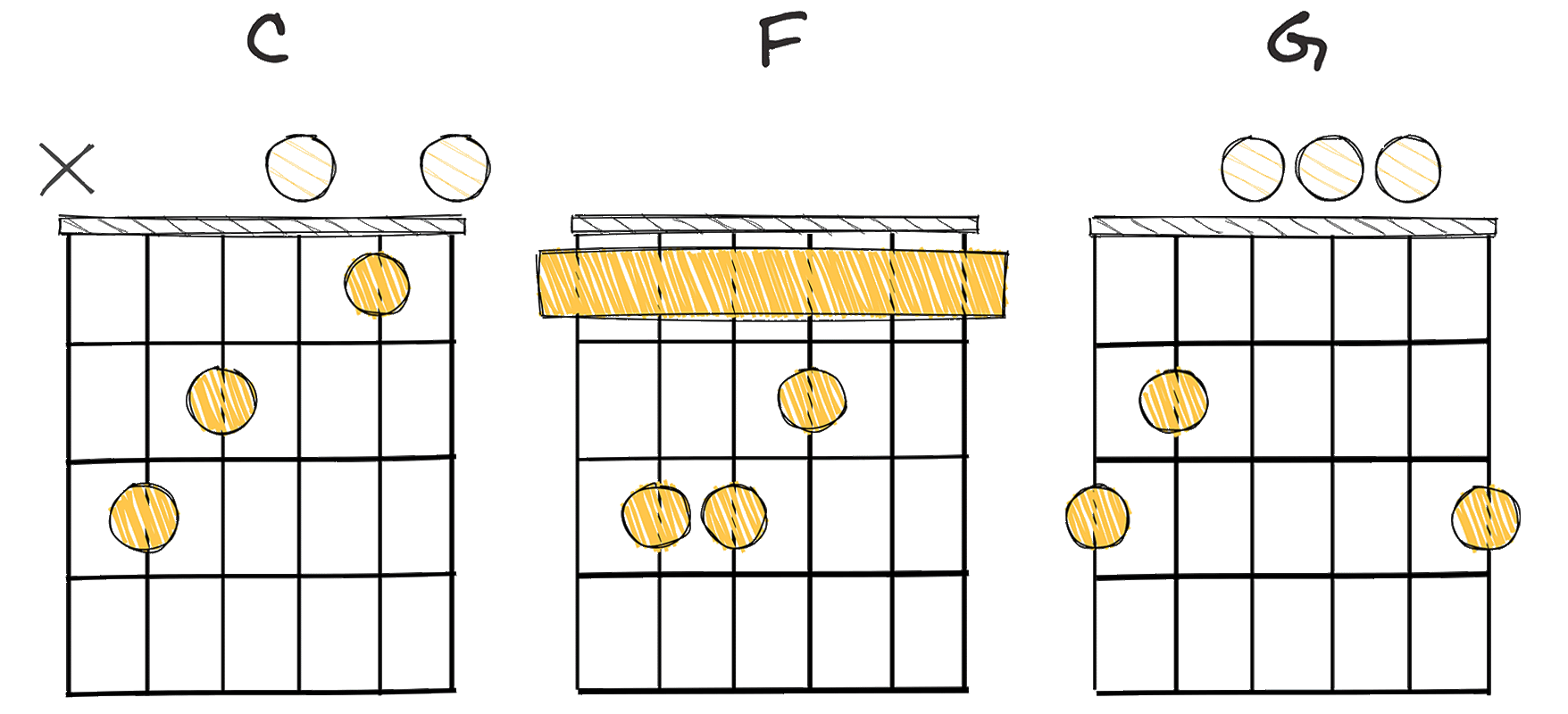
Our first chord progression is the very basic I – IV – V structure, also referred to as a 1-4-5 chord progression.
Often described as the ‘backbone’ of popular music, the I-IV-V progression has proven to be incredibly popular in its simplicity and versatility throughout musical history.
The I-IV-V progression is especially common in genres such as blues, rock, and pop.
In the key of C, which we are using for demonstration, I, IV, and V would translate to the C major, F major, and G major chords, respectively.
This progression basically moves upwards from the root or tonic chord (I or C major in this case) to the fourth (IV or F Major) then to the fifth (V or G major).
The movement from the tonic to the fourth and then to the fifth gives songs a kind of uphill-downhill structure that’s pleasing to the ear.
Moreover, this pattern ties back to the tonic chord, thus creating a sense of musical completeness and resolution.
As a beginner guitarist, the I-IV-V progression offers an easy and efficient way to start learning and understanding the logic behind chord progressions.
Since it’s built from major chords, this progression has a typically upbeat, happy sound that you’ll recognize from many popular songs.
Mastering this progression is just one of the first steps on your journey into understanding chord structures and theory.
With practice, one can play various songs merely by recognizing their I-IV-V pattern and transposing it to the appropriate key.
This chord progression is easy to play and learn, making it ideal for a beginner guitarist, and it opens up a world of possibility for song-learning and song-writing.
From rock to pop, country to blues, the I-IV-V progression has proven its worth in the annals of music history and remains a favorite among guitarists of all skill levels.
I – V – vi – IV (1-5-6-4)
A universal, beginner-friendly chord progression with a resonating impact.
This I-V-vi-IV progression is one of the most common patterns found in pop music, providing a simple yet melodically rich sequence for beginner guitarists. Its mixture of major and minor chords creates an emotional sequence, making it popular among songwriters and a great starting point for beginners to learn and practice.
- Example: C – G – Am – F (Key of C)
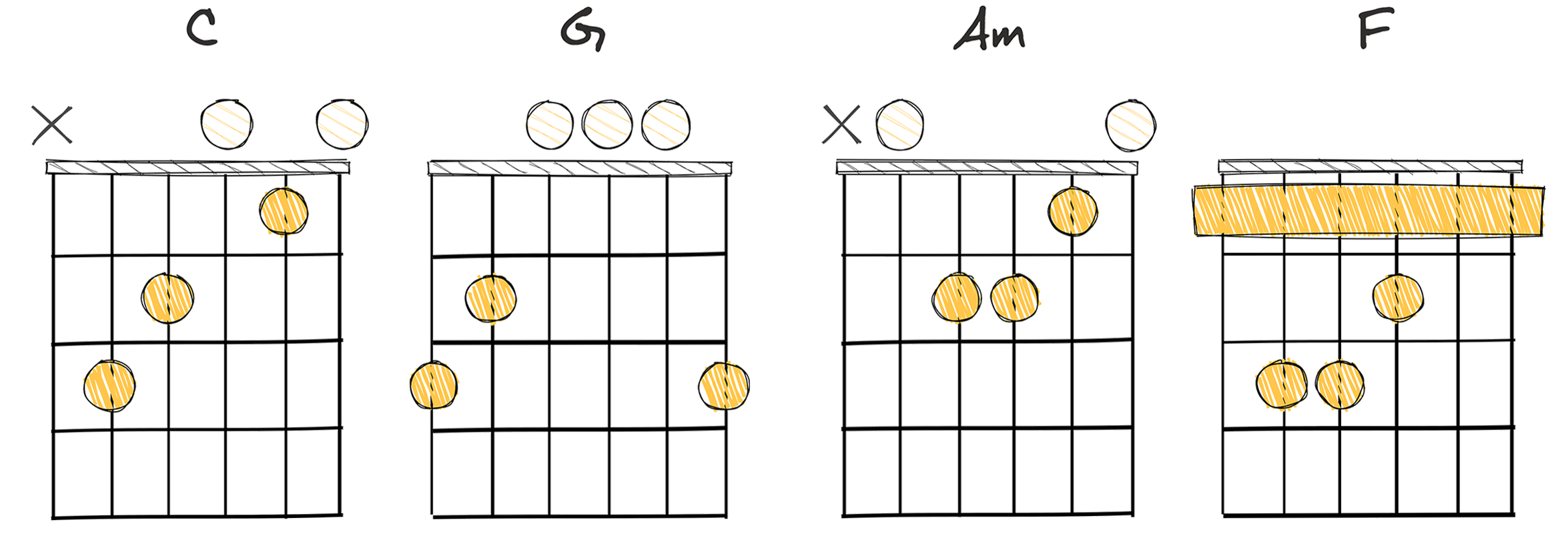
The I – V – vi – IV chord progression, represented in the key of C as C – G – Am – F, is an easy and incredibly popular chord progression used in a wide range of songs across various genres.
This chord progression is simple and ideal for beginner guitarists, as it incorporates basic chords that can be easily mastered.
The I – V – vi – IV progression creates a perfect foundation for adding embellishments or variations making it a versatile tool for songwriters and composers.
This progression is flexible and enables the addition of various melodic and rhythmic inflections.
This creates unique sounding music while still maintaining the familiar core structure.
Since it only requires the knowledge of four basic chords, it ensures that beginners can easily practice switching between chords, thus building their chord transition skills.
Historically, the I – V – vi – IV sequence has a deep-rooted presence in popular music, dating back to classical music eras.
Its popularity in genres such as pop, rock, and even reggae underscores its versatility and resonance with varied audiences and musical styles.
Furthermore, the I – V – vi – IV progression has a unique quality, creating a pleasing and catchy melody that is instantly recognizable and appealing to listeners.
This chord progression is truly a gateway, helping beginner guitarists unlock their potential and creativity in a structured yet accessible way.
ii – V – I (2-5-1)
The fundamental building block of jazz harmony.”
The ii-V-I progression, also known as 2-5-1, is one of the most common and important chord progressions in music, frequently used in jazz and popular music. It is a key cornerstone for a beginner guitarist as it helps a musician understand fundamental theories about chords and harmony.
- Example: Dm – G – C (Key of C)
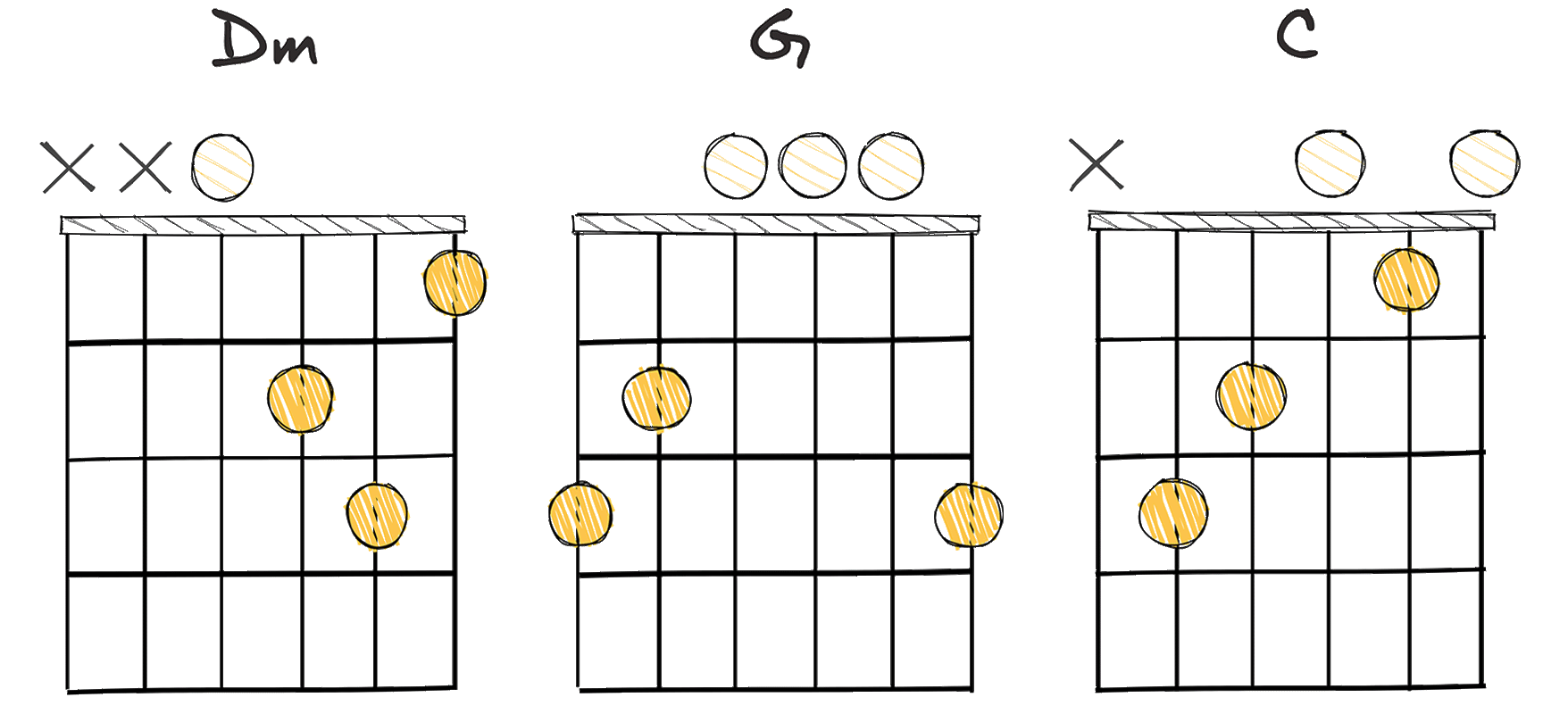
The ii – V – I (2-5-1) chord progression is one of the essential progressions that beginner guitarists need to know.
This progression, which consists of the second (ii), fifth (V), and first (I) chords in a key, is known as the very basic foundation in most genres of music, especially in jazz.
Despite its association with complex jazz music, the ii – V – I progression is quite easy to play on the guitar, which is why it is great for beginners to understand and practice.
The history of the ii – V – I progression stretches back to the development of western classical music and can be found extensively throughout Baroque, Classical, and Romantic-era compositions.
This historical footprint gives the progression a timeless quality and demonstrates its fundamental role in shaping musical sound.
Turning to jazz, the ii – V – I progression became even more prevalent, anchoring many standards and forming the basis for countless improvisations.
In the key of C, the ii – V – I progression would be Dm – G – C.
As a beginner guitarist, understanding how the chords within this progression relate to one another, both in terms of sound and finger placement, can significantly enhance your playing ability.
When practicing this progression, try to listen for the musical ‘journey’ the chords take you on – this journey from dissonance, through tension, to resolution is one of the fundamental concepts in music.
Start slow, and make sure each chord is ringing out clearly before speeding up or adding in any rhythmic elements.
Breaking it down, you can practice the Dm chord in isolation first, followed by the transition to the G and then from the G to the C.
Working on each piece of the progression separately ensures you can transition smoothly and accurately between chords before putting the entire progression together.
Your end goal should be to move fluidly from the Dm, to the G, and then to the final C chord without any break in rhythm or hesitation.
With practice, the ii – V – I progression can open up a world of song possibilities and can serve as a fundamental building block in your growth as a guitarist.
I – vi – IV – V (1-6-4-5)
This progression forms the backbone of countless pop and rock songs.
This chord progression, I – vi – IV – V, is one of the most popular and enduring in music, known for its balanced, pleasing sound. It’s an excellent progression for beginner guitarists to learn due to its simple structure, and it can be the backbone of a wide variety of songs across many genres.
- Example: C – Am – F – G (Key of C)
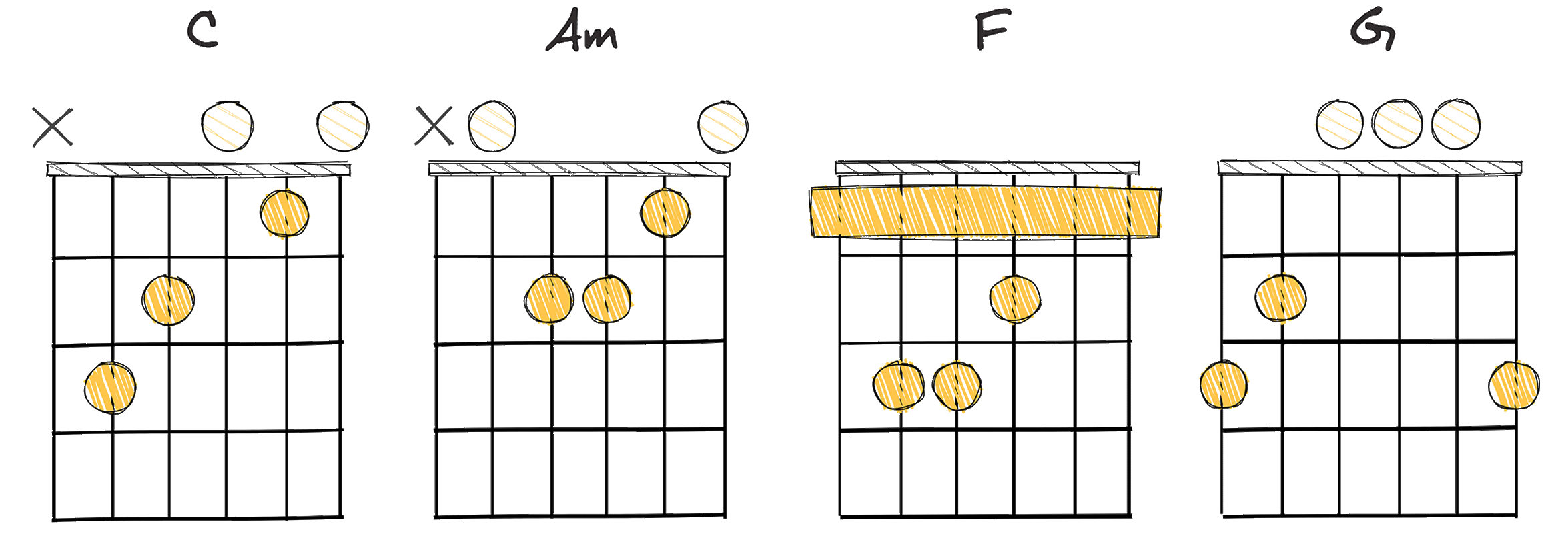
Most beginners find chord progression a daunting task, but the I – vi – IV – V (1-6-4-5) is often viewed as one of the easy chord progressions for any beginner guitarist to grasp.
Given the often complex site of many chords for a beginner, it is a nice surprise to encounter a progression such as this that is easier to handle.
The I – vi – IV – V (1-6-4-5) progression is simple and easy to understand, but carries a full, rich sound that makes it popular in many types of music.
It’s also very conducive to improvisation, making it a favorite among guitarists from a variety of genres.
One of the important aspects that make I – vi – IV – V (1-6-4-5) progression easy for beginners is its remarkable consistency, regardless of the key you’re playing it in.
This means that once you have mastered this progression in one key, you can easily apply it to other keys.
Another feature that makes this progression an excellent starting point for beginners is that it uses four of the most common chords found in popular music: the tonic (I), the relative minor (vi), the subdominant (IV) and the dominant (V).
This combination of chords provides a versatile and melodious structure that is pleasing to the ear.
Widely used by iconic musicians throughout history, the I – vi – IV – V (1-6-4-5) progression has been instrumental in creating some of the most memorable songs in music.
For any beginner finding their path in the world of guitar playing, having a grasp of this progression is like acquiring a crucial tool for their toolbox.
It is a progression that enables them to understand the foundation of numerous songs and provides them with the framework to create their own.
While there always remain plenty to learn and master on the guitar, knowing a few essential progressions such as I – vi – IV – V (1-6-4-5) is a helpful step to bridging the gap between a beginner and an intermediate player.
By understanding and practicing this easy chord progression, any beginner can improve their guitar playing skills and gain confidence on their musical journey.
vi – IV – I – V (6-4-1-5)
This progression brings a soulful balance to beginner guitarist tunes.
This is a basic, but powerful chord progression used often in pop and rock music, giving a satisfying sense of resolution and conclusion. The progression, vi-IV-I-V, starts with the sixth chord, moves to the fourth, returns home to the first chord, and then amps up the drama with a trip to the fifth before starting all over again.
- Example: Am – F – C – G (Key of C)
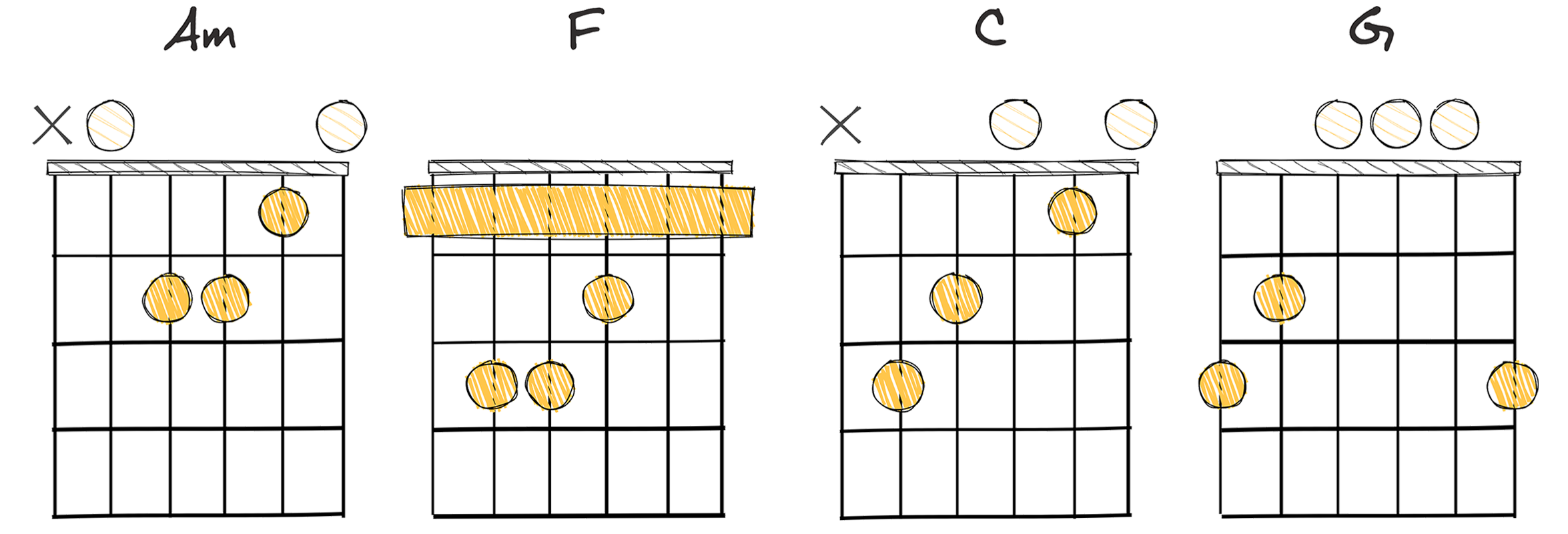
The vi – IV – I – V (6-4-1-5) chord progression is a progression that is designed in such a manner to supply a harmonious explosion of musical notes.
This chord progression, broken down into the Am – F – C – G in the key of C, or otherwise numerically represented as vi – IV – I – V (6-4-1-5), is a testament to the genius of music.
The dynamics of this progression plays a magnificent role in creating beautiful melodies.
This is because it balances between minor and major chords, generating a contrasting yet complementary mixture of musical emotions.
Following the aforementioned quote, the balance achieved between the minor and major chords in this progression results in a very compelling output.
Undeniably, it opens up a plethora of musical avenues for any aspiring beginner guitarist.
The utilization of this chord progression dates back many years, and it has had an indelible impact on contemporary music.
Its history is etched in countless songs across numerous genres.
On the basis of its simplicity, the vi – IV – I – V (6-4-1-5) progression is highly recommended for beginner guitarists.
The ease of playing this chord sequence only elevates its appeal, thereby allowing novice musicians to produce a rich variant of sounds.
In the effort to play this progression, the transition between chords is vital.
It paves the way for the smooth shift from one chord to the next, contributing to the rhythm of a song.
Considering its ability to be worked into various musical styles and genres, it offers a sea of possibilities for new guitarists to explore their creativity.
From rock ballads and pop anthems to country tunes and blues, the application of this chord progression is virtually endless.
Its adaptability and elasticity, as well as the perennial popularity of the vi – IV – I – V (6-4-1-5) chord progression, make it an integral element in the world of music.
No discussion on this chord progression would be complete without mentioning its role in melody formation.
Hinging on the root chord helps in composing charming and captivating melodies for any piece.
Cherished by music enthusiasts and revered by musicians, the vi – IV – I – V (6-4-1-5) chord progression epitomizes the allure and magic of music composition.
While the sophistication and complexity of music theory may be intimidating for a beginner, this chord progression serves as a reassuring testament to the beauty of simplicity.
I – IV – V – IV (1-4-5-4)
Ideal progression, granting beginners a simple journey through fundamental chords.
The I-IV-V-IV chord progression is a simple yet powerful sequence commonly used across various genres of music. It’s a great starting point for beginner guitarists as it involves only three basic chords, allowing them to get comfortable with chord transitions while creating pleasing, recognizable harmonies.
- Example: C – F – G- F(Key of C)
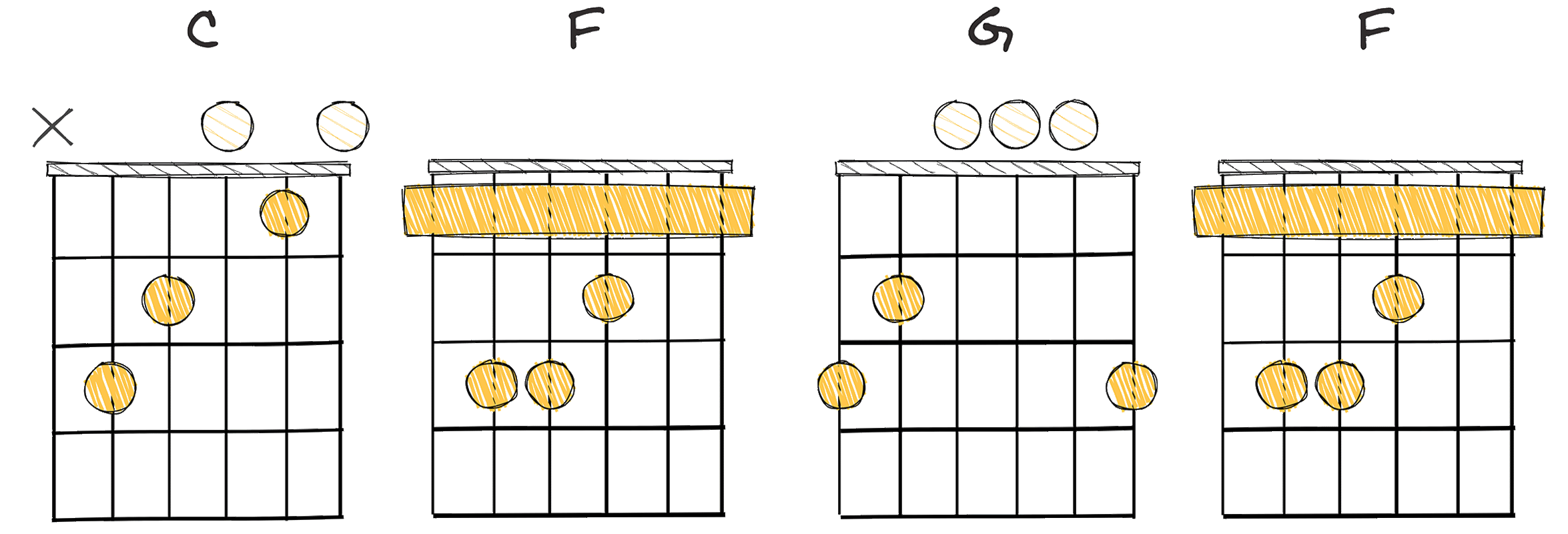
Learning chord progressions is a critical part of mastering the guitar.
Not only does it help in understanding the structure of songs, but it also provides a roadmap for crafting your melodies.
In this section, we will focus on the progression – I – IV – V – IV (1-4-5-4) also known as C Major – F Major – G Major – F Major in the Key of C.
This progression is one of the fundamental sequences in music and is part of countless popular songs across varying genres.
Popularized by blues musicians, the I – IV – V – IV progression has an enduring legacy in the world of guitar music.
The blues genre, deeply rooted in the African-American history, utilized this progression dramatically, leading to its wide recognition and use.
Over time, it also found its way into rock, country, and even pop music, influencing countless musicians and shaping the sound of modern music.
This progression’s simplicity and versatility are what make it so commonly used, especially for beginner guitarists.
The chords in this progression, C major, F major, and G major, are all easy to play, and transitioning between them is straightforward, even for newcomers to the instrument.
Furthermore, the repetitive pattern of going back to the IV chord (F major) adds a familiar and comforting rhythm to the progression, perfect for beginners.
As aspiring guitarists, practicing this progression improves your technical skills and boosts your understanding of musical structures and songwriting methods.
Remember, knowledge of chord progressions is not just about strumming a series of chords but interpreting and expressing music in its most profound sense.
ii – vi – I – V (2-6-1-5)
A classic, versatile chord progression ideal for beginner guitarists.
The ii-vi-I-V progression is a simple yet versatile sequence that is fundamental to many different genres of music, making it perfect for beginner guitarists. This progression consists of four chords: the minor supertonic, minor submediant, major tonic, and dominant, offering a smooth and predictable pattern while still providing a rich harmonic foundation.
- Example: Dm – Am – C – G (Key of C)
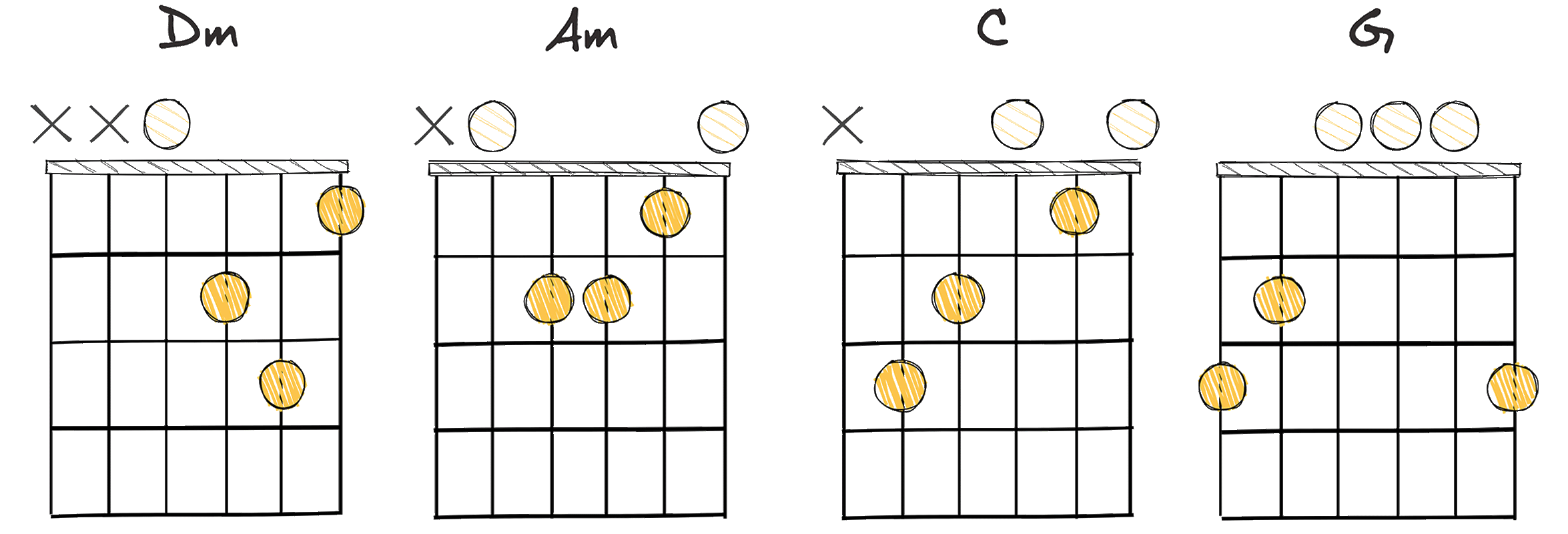
The ii – vi – I – V chord progression (2-6-1-5 in the Key of C, for instance) is an incredibly versatile and easy-to-play progression that can be a great starting point for beginner guitarists.
This commonly used progression, represented in the key of C as D minor (Dm), A minor (Am), C major (C), and G major (G), is a staple in a variety of musical genres, from rock and pop to jazz and blues.
Historically, the ii – vi – I – V progression was heavily utilized in the Baroque period of music, but it has certainly stood the test of time. One can easily recognize these harmonic movements in countless songs from the past several decades.
As a beginner guitarist, the ii – vi – I – V progression is particularly accessible due to the minimal movement required between chord shapes, especially in the open position.
Whereas some progressions may require a significant amount of finger stretching or difficult bar chords, the 2-6-1-5 progression can be played using primarily open chord shapes, making it a great introduction to chord progression practice for beginners.
Given that all four chords in this progression are in the key of C, this allows the player to produce a harmonious sound without having to navigate complex chord changes.
From this quote, it’s clear to see just how suitable this progression is for beginners.
Having all chords within the same key not only simplifies the playing but it also provides a firm foundation for understanding music theory, specifically harmonics within a key.
Once comfortable with the chord shapes and transitions in the key of C, you might start exploring the same progression in different keys.
Moreover, one of the advantages of the ii – vi – I – V progression is that it loops quite seamlessly, allowing for continuous play and practice without abrupt stops or changes in pattern.
The ii – vi – I – V progression (2-6-1-5) is not just for beginner guitarists; its simplicity and versatility make it a valuable tool in the repertoire of any musician. The progression’s historical relevance and ease-of-play makes it a popular choice in many popular modern and classical music genres.
As your skill and comfortability with this progression improve over time, you’ll find ways to incorporate it and experiment with it in your own music, potentially creating a delightful array of melodies and harmonies.
I – IV – ii – V (1-4-2-5)
A staple progression, perfect for beginners to practice transitions.
This progression, I – IV – ii – V, is a beginner-friendly sequence commonly used in many popular songs across several genres. Often known as the ‘1-4-2-5’ progression, it provides an easy and memorable structure for any novice guitarist to learn, practice, and apply in their own music making.
- Example: C – F – Dm – G (Key of C)
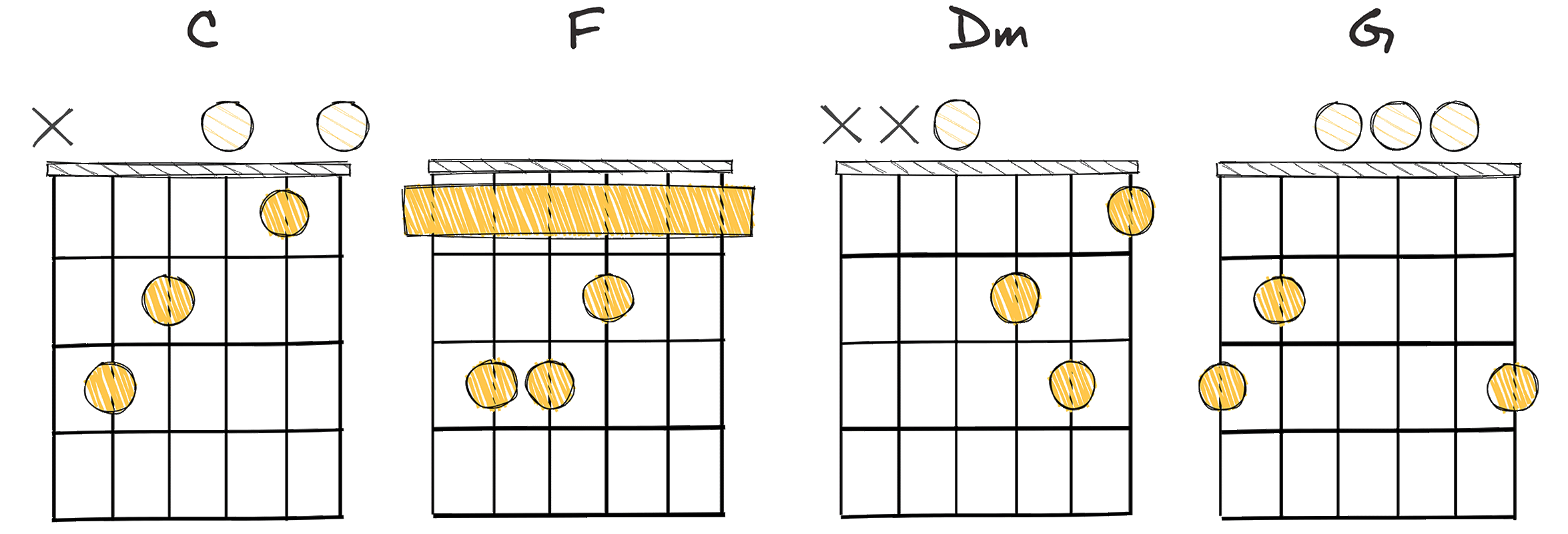
The I – IV – ii – V is one of the popular and easy chord progressions that any beginner guitarist should master.
This 1-4-2-5 progression is a vital knowledge in the realm of music, particularly for those playing the guitar.
Quite like the universal language of mankind, music has defined and recognizable patterns that seem to touch the hearts of many, and the I – IV – ii – V progression falls perfectly into this category.
An interesting fact about this chord progression is its innate ability to create a pleasant and harmonious tune that engages listeners.
Transformed into the concrete form of guitar chords such as C – F – Dm – G, when in the key of C, the design of the I – IV – ii – V progression becomes visually and audibly clear.
This conceptual illustration provides handy guide for beginners.
Navigating the fretboard can be less overwhelming and the chords can be learned smoothly.
The history of chord progressions is an integral part of the grand narrative of music itself.
The real advent of progressions can be traced back to the age of classical music, where the greats like Mozart and Beethoven utilized progression-like structures to create some of the infamous symphonies that we know today.
Fast forward to the era of rock ‘n’ roll or even modern pop, the I – IV – ii – V progression has been commonly used to construct some of the most popular songs over the past decades.
Despite its simplistic nature, the 1-4-2-5 progression offers unlimited potential to create riveting and enjoyable music.
The wonder of music lies in its limitless boundaries for innovation and the I – IV – ii – V progression is no exception to this universal law of music.
vi – V – IV – I (6-5-4-1)
A smooth, beginner-friendly progression with a comforting resolution.
The vi – V – IV – I chord progression, commonly referred to as 6-5-4-1, is a simple and popular sequence often used in a variety of music genres. Its simplicity and melodic resonance makes it ideal for amateur guitarists as they start to explore different sequences and develop their playing skills.
- Example: Am – G – F – C (Key of C)
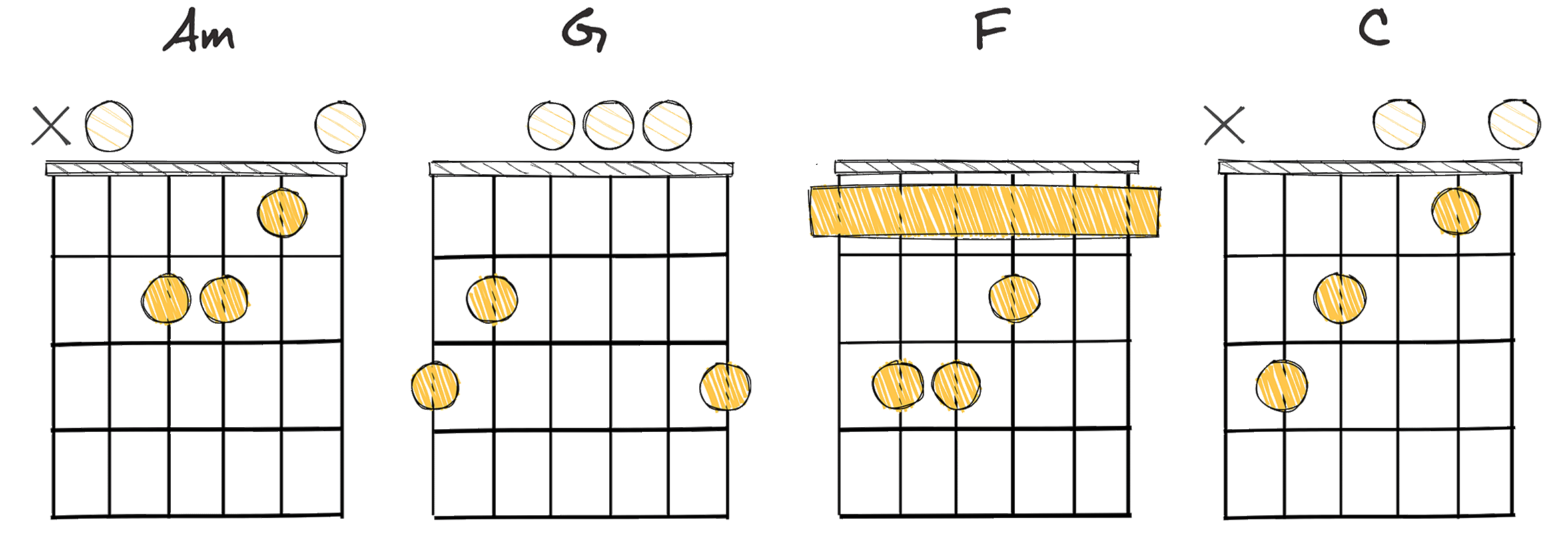
The vi – V – IV – I (6-5-4-1) progression, commonly known as the six-four-one-five, is a popular approach in many genres of music, not just in the realm of rock and pop but also in blues, country, and jazz.
This easy and memorable chord progression offers a solid structure for song composition, which can be readily adapted to match diverse moods and themes.
One of the reasons this progression is so popular is because it is incredibly easy to play, even for beginner guitarists.
In simpler terms, for those playing in the key of C, the vi – V – IV – I progression equates to the chords Am – G – F – C.
This gives the guitar player an opportunity to gain comfort with a variety of key chords.
Additionally, the movement between these chords is minimal, which allows the guitarist to transition smoothly and easily.
As for its musical history, it has been used extensively in 20th-century pop and rock music.
This chord progression is commonly found in many hit songs, and its popularity continues to endure in current music trends.
It is important to note, however, that while the vi – V – IV – I progression can certainly stand on its own, many artists and composers will often mix it with other chord progressions to create a more complex musical tapestry.
This does not take away from the simplicity of the progression itself, but adds another layer of depth and intricacy to the composition.
The vi – V – IV – I progression is a tried-and-true foundation upon which many guitarists have built their songwriting and performing skills.
Not only does it provide an easy introduction to chord transitions for beginner guitarists, but it also introduces them to a key aspect of music theory and composition.
Ultimately, mastering this progression can open up an entirely new world of musical possibilities.
By understanding it, trying it out, and getting the hang of it, beginner guitarists are taking a significant step towards developing their overall musical prowess.
IV – I – IV – V (4-1-4-5)
Simple, classic progression ideal for novice guitarists to practice.
This progression, IV – I – IV – V, is a simple yet effective combination of chords that is perfect for beginners learning the guitar, ensuring they get a hold of rhythm and technique. The transition from the ‘subdominant’ 4th chord to the ‘tonic’ 1st, then back again and ending with the ‘dominant’ 5th chord, instills a sense of harmony and melodic structure, forming the backbone of countless songs across various genres.
- Example: F – C – F – G (Key of C)
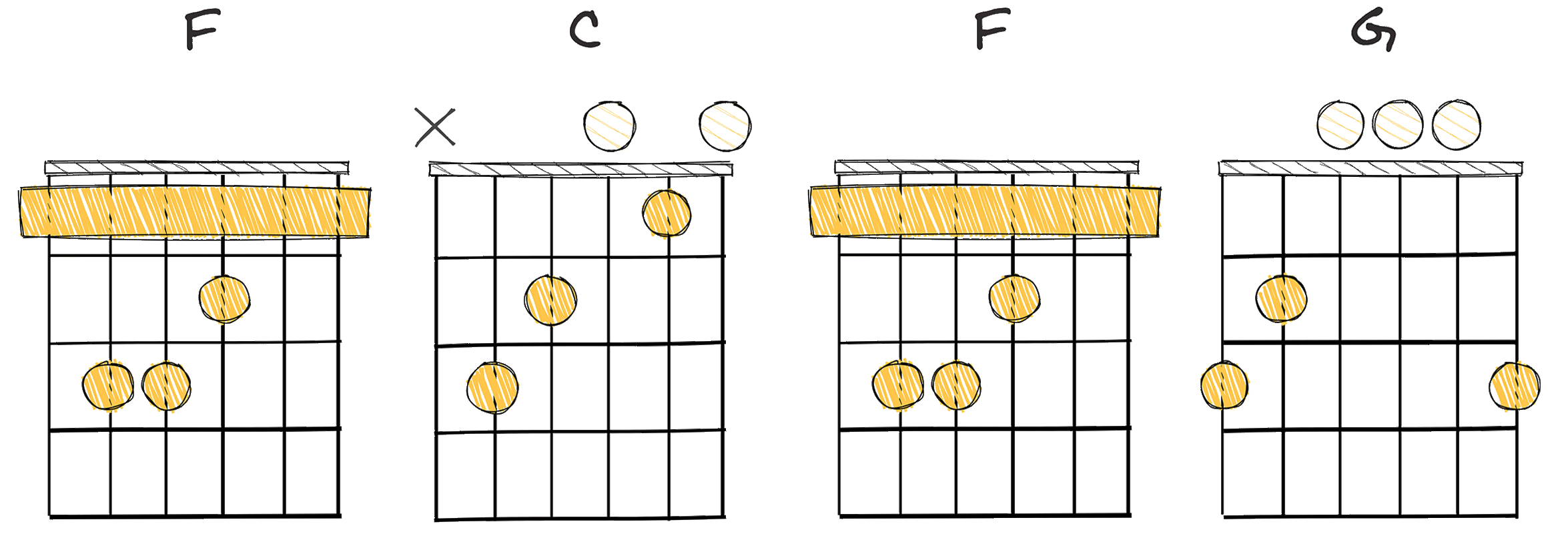
One of the simplest and most commonly used chord progressions in popular music is IV – I – IV – V.
It’s an excellent progression to start any beginner guitarist’s journey.
Also known as the 4-1-4-5 progression, this arrangement of chords often serves as the backbone for many well-known songs.
The progression is easy to play, allowing beginners to become more comfortable with their guitar while also providing a solid foundation of timing and chord changing skills.
Hence, this popular progression is effectively suited to guide the guitarist through the process of learning, reinforcing the fundamental chord shapes, and reinforcing the skill of changing chords smoothly.
With practice, this progression enables the learner to form a solid basis of playing rhythm in any music genre.
The beauty of the IV – I – IV – V progression is not just easy to play, but its rhythmic simplicity is loved and appreciated by artists and listeners alike.
Because of the simplicity and versatility of the IV – I – IV – V progression, not only have they remained prevalent in music over many decades but they have been the foundation of countless classic songs.
This progression is, indeed, a historical constant across a wide range of genres – from rock to pop, from blues to country.
In the hands of any creative musician, the IV – I – IV – V progression becomes a powerful tool that can be used to write songs that are simultaneously fresh, yet familiar.
IV – I – IV – V has a friendly, inviting quality, making songs with its structure particularly suitable for large live shows and intimate performances alike because of its ability to connect with the listeners on a deeply personal level.
I – vi – ii – V (1-6-2-5)
A classic, smooth transition ideal for beginner guitarists’ exploration.
The I-vi-ii-V chord progression, known as the 1-6-2-5, is a simple yet versatile series of chords that is perfect for beginner guitarists to practice and master. It is commonly used in various genres of music and learning it can provide a great basis for understanding fundamental principles of harmony and chord movement.
- Example: C – Am – Dm – G (Key of C)
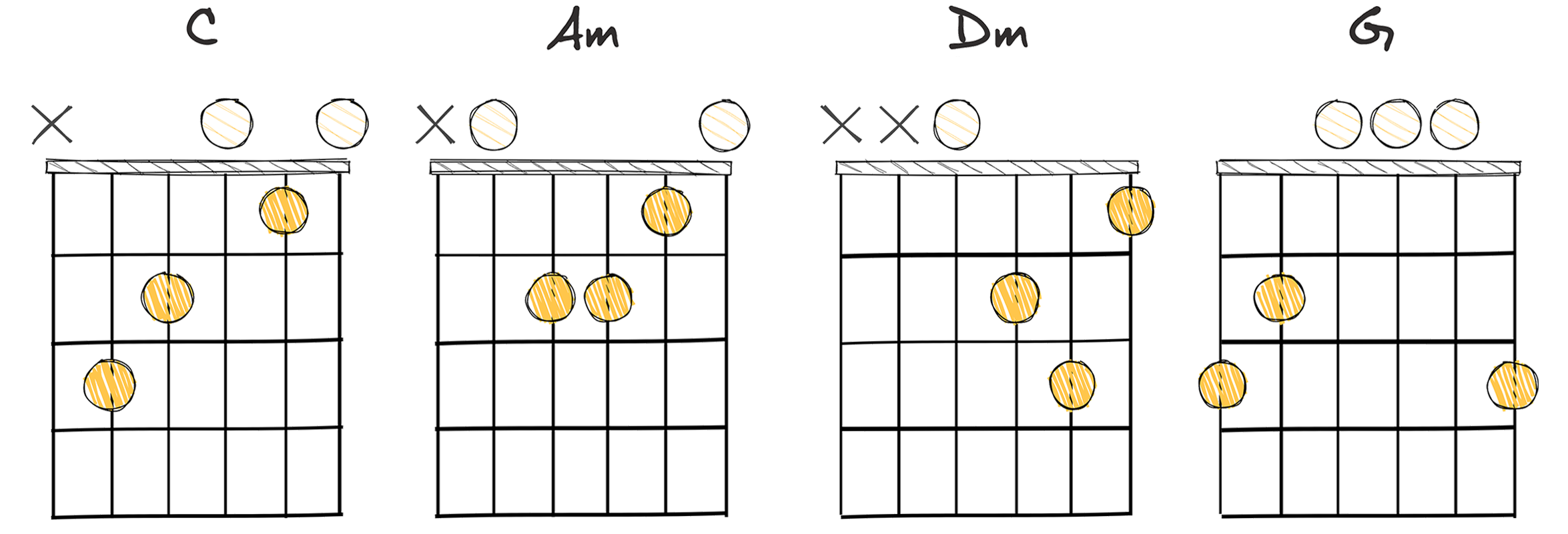
The chord progression of I – vi – ii – V (1-6-2-5) is often regarded as an essential and simple progression that every beginner guitarist should understand and practice.
It’s known for being relatively easy to play, especially for those who are just starting their journey with the instrument.
Bearing a rich history, this chord progression is successful in creating a pleasing harmony that resonates with listeners.
Notably, the chord progression of I – vi – ii – V has been used in many hit songs, proving its popularity among songwriters and musicians alike.
The relevance of this progression within popular music further emphasizes its appeal and importance.
It’s frequently applied in various genres and styles of music, giving it a wide-scale appeal that has continued to endure through the ages.
Furthermore, this specific chord progression features the dominance of the I (tonic) chord, which helps in establishing a robust tonal center.
Transitioning from this chord to other chords within the progression creates a dynamic and engaging melodic movement.
Learning this progression is not just about mastering these specific chords but also understanding how chords interact and flow together to create a cohesive musical phrase.
Recognizing these patterns and chord relationships is a vital skill for any budding guitarist or songwriter.
The I – vi – ii – V (1-6-2-5) chord progression’s versatility contributes significantly to its continuing prominence in popular music.
It offers a solid foundation from which beginners can work and experiment, encouraging further exploration of chord progressions and guitar playing in general.
Its simplicity and pleasing sound make it an excellent starting point for those who are picking up the guitar for the first time and navigating their way around the fretboard.
Given the versatility and simplicity of the I – vi – ii – V (1-6-2-5) chord progression, its continued usage in songs across different genres is not surprising.
ii – I – V – IV (2-1-5-4)
A beginner-friendly progression that provides variety beyond the norm.
The ii-I-V-IV chord progression is a fundamental sequence used in various genres of music, notable for its simplicity yet distinct sound. Ideal for beginner guitarists, this progression forms a harmonic foundation that’s easy to master, offering a solid basis to build upon and experiment with more complex pieces.
- Example: Am – G – D – C (Key of G)
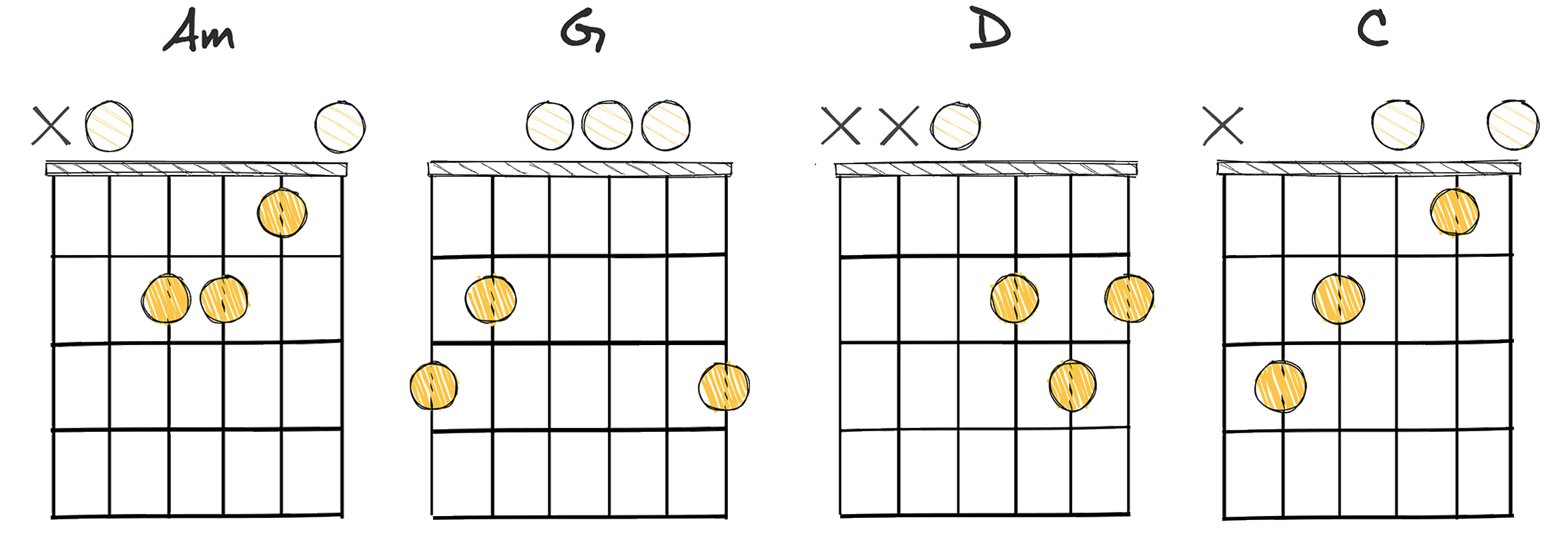
The chord progression ii – I – V – IV (2-1-5-4), or in the key of G, Am – G – D – C, is a fantastic place to start for any beginner guitarist.
Used frequently in a variety of genres, this progression provides an excellent foundation for learning and understanding chord relations.
This chord progression, Am – G – D – C, has a rich history in music, marking its presence in a myriad of classic and contemporary songs.
Some may argue that knowing the lineage of a chord progression intimates a deeper understanding of its application.
The rich history of this chord progression is vast and varied, ranging from the bluesy rhythms of the mid-20th century to the pop tunes of today.
Notably, this progression has maintained its relevance across eras, bearing witness to the ever-evolving landscape of musical expression.
Ease of play is one of the fundamental reasons why this progression is recommended for beginners.
The sequence of Am – G – D -C does not involve complex finger positioning or challenging transitions between the chords.
By learning this progression, the beginner guitarist also gains the ability to play along with countless songs, fostering quick gratification that can help maintain momentum in learning to play.
Owning the confidence to play a well-known song can be a powerful motivator for any beginner guitarist, affirming their progress and encouraging continued practice.
Is the 2-1-5-4 progression in the key of G simple?
Yes. Does it carry a wealth of musical heritage and potential for experimentation?
Most definitely.
Therefore, learning this chord progression not only teaches a beginner how to navigate the guitar but also instills a sense of the rich musical heritage they are now part of.
IV – V – I – vi (4-5-1-6)
Perfect chord progression for beginners seeking a catchy tune.
The IV – V – I – vi progression is a popular and fundamental sequence often found in various genres such as pop, rock, and classical music. It’s an ideal starting point for beginners on guitar, providing a simple yet versatile foundation for exploring songwriting, improvisation, and the basics of music theory.
- Example: C – D – G – Em (Key of G)
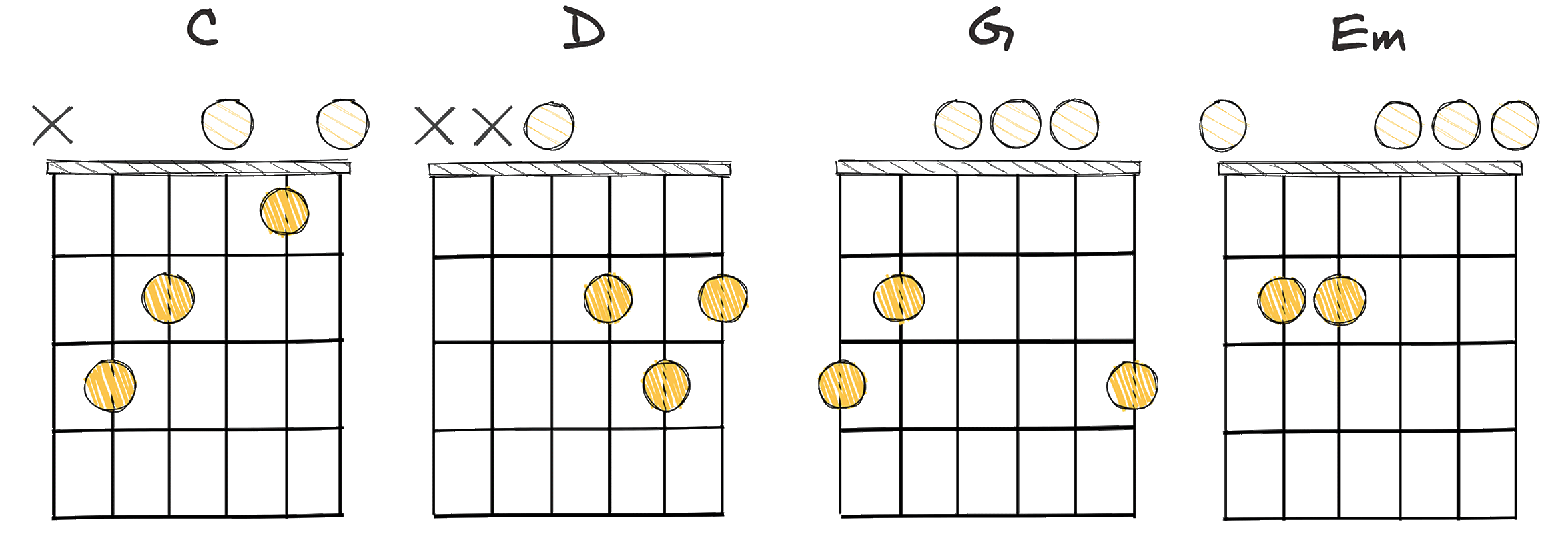
The IV – V – I – vi chord progression (4-5-1-6), specifically in the key of G Major (C Major, D Major, G Major, E Minor), is a great starting point for any beginner guitarist.
Due to its simplistic nature, this chord progression is an ideal choice for beginners trying to familiarize themselves with the guitar and the concept of chord progressions.
One of the reasons these chord progressions are perfect for beginners is because of the natural flow of the chords from one to another.
Historically, the IV – V – I – vi progression dates back centuries and is one of the most common progressions used in western music.
This popularity isn’t without merit – these chord progressions have a definitive sound that is harmonically pleasing to the ear.
In this progression, the IV – V – I creates a harmonically complete phrase, the vi chord then expands on that.
The addition of the vi chord, the E minor in this case, provides a dramatic juxtaposition to the otherwise perfect cadential ending.
The striking contrast between the major and minor chords creates an interesting dynamic, adding emotional depth to the piece of music.
The progression seamlessly blends a mix of major and minor chords, producing an inherently satisfying and complete sound to the listener.
Furthermore, these chords are all found within the same diatonic scale, making them easy to navigate on the fretboard.
I – IV – vi – V (1-4-6-5)
A harmonious journey from brightness to melancholy, perfect for beginners.
This chord progression, I-IV-vi-V, is a common and easy sequence ideal for beginner guitarists to learn and familiarize themselves with. It provides a melodic and uplifting sound, often used in various genres such as pop and rock, making it versatile for practice and performance.
- Example: C – F – Am – G (Key of C)
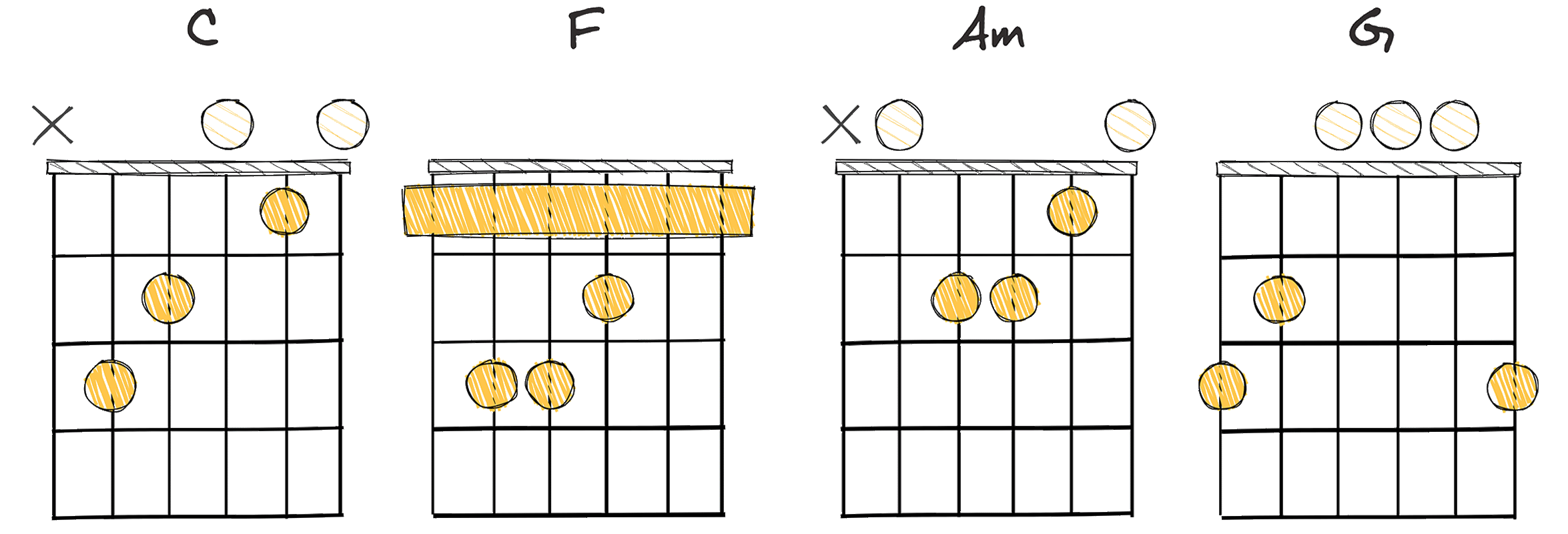
The I – IV – vi – V (1-4-6-5) chord progression is considered one of the fundamental foundations in Western music, particularly in the popular music genre.
This chord progression, often referred to as the “pop-punk progression”, has a rich history, tracing back to the classical era and up to the present day.
It is prevalent across various genres such as pop, rock, punk, and even in country music, making it a valuable asset for any beginner guitarist.
The progression’s simplicity and versatility make it easy for any beginner guitarist to pick up and implement across a range of musical styles and genres.
Its simplicity stems from the fact that it only involves four basic chords, typically the C,F,Am,G (in the key of C) for many popular songs.
From a beginner’s perspective, these chords are easy to master
The I-IV-vi-V progression’s versatility stems from its ability to evoke different moods and feelings, depending on the rhythm, tempo, and how the chords are voiced.
Moreover, its ubiquitous nature in popular music means that beginners can apply this progression in playing numerous songs, thereby enhancing their musical repertoire.
One might see the versatility of this chord progression as an indicator of its effectiveness.
Even if beginners only know this progression, they can still play a large number of songs across various genres, allowing them to keep growing and having fun while they learn.
As an aspiring guitarist familiarizes themselves with this chord progression, they develop their guitar skills as they navigate through the fretboard with ease.
They can gradually build up the speed at which they shift from one chord to the next, and even incorporate additional techniques to amplify their performance.
While this progression’s origins can be traced back to classical music, its evolution over time and its enduring presence in modern music testify to its timeless appeal.
iv – I – V – vi (4-1-5-6)
This progression offers a melancholy twist, perfect for aspiring balladeers.
The iv-I-V-vi chord progression is a commonly used sequence in popular music that transitions from the minor subdominant (iv) to the tonic (I), dominant (V), and then submediant (vi). This progression produces a unique melodic sound that is beginner-friendly, capable especially of producing a range of emotions from sad to uplifting, making it a great starting point for any newbie guitarist.
- Example: Fm – Bb – Eb – Gm (Key of Bb)
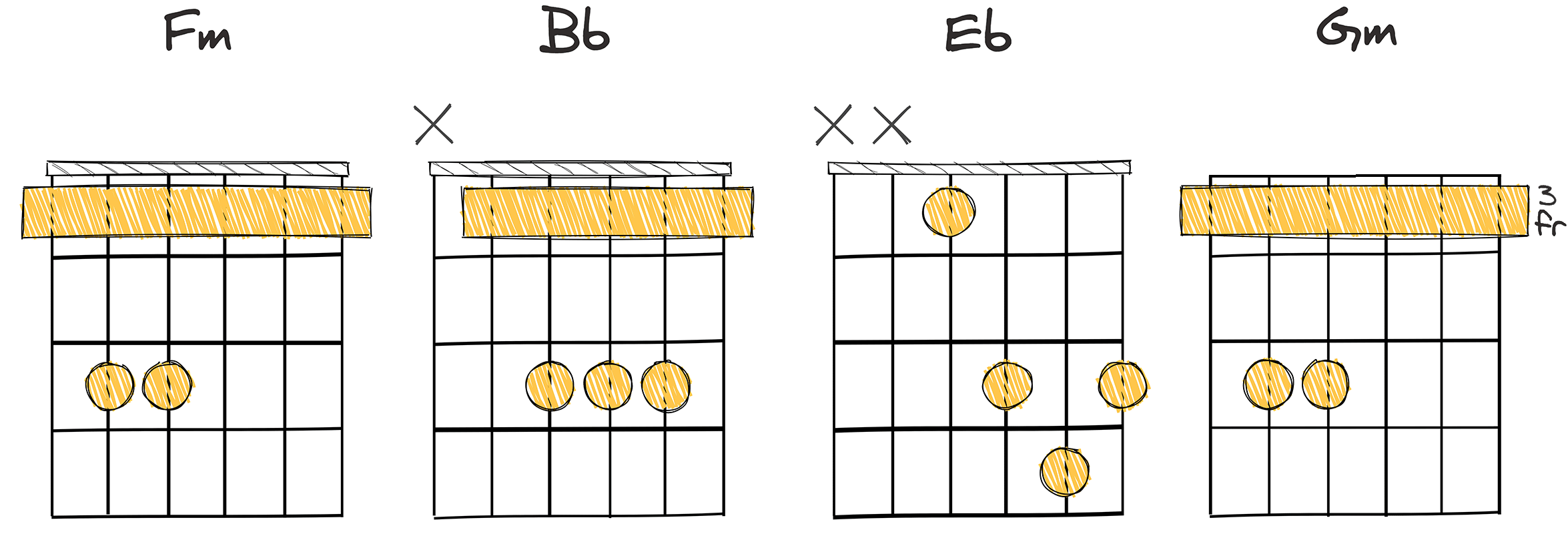
The chord progression iv – I – V – vi (4-1-5-6), which in the Key of Bb is Fm – Bb – Eb – Gm, is one of the easiest and most recognizable progressions for any beginner guitarist.
This progression is especially easy to play because it consists of only four chords and those chords are fairly straightforward to form on the guitar.
Moreover, these chords can be played in an open position, which allows the beginner guitarist to focus more on their strumming technique rather than on their finger placement.
Furthermore, this progression is widely used in popular music, making it an excellent choice for those looking to learn songs they recognise.
This progression has a rich history, being used in countless songs across various genres.
Its universal appeal and accessibility have contributed significantly to its popularity.
Moreover, because it is used so frequently, it provides a great foundation for learning other, more complex progressions.
One prime example of a song that uses this progression is Leonard Cohen’s famous piece, “Hallelujah.”
In this song, the Fm – Bb – Eb – Gm progression is used to create a soothing and melancholic mood which complements the song’s lyrics perfectly.
So, whether you’re a budding guitarist looking for easy-to-play chord progressions or an aspiring songwriter seeking to understand the fundamentals of composition, this progression is a perfect starting point!
Finally, remember that playing the guitar is not just about mastering chord progressions, it’s also about enjoying the process and expressing yourself through music.
No matter where you are in your guitar journey, the 4-1-5-6 progression is a great tool to have in your arsenal, and with practice, it will surely become second nature.
V – IV – I – ii (5-4-1-2)
This progression provides a simple, yet melodically interesting foundation for beginners.
This chord progression is simple yet effective, starting on the dominant (V), stepping back to the sub-dominant (IV), before resolving on the tonic (I), and finally adding a touch of contrast with the supertonic (ii). It’s a popular progression that’s great for beginners to practice, providing a solid foundation and versatility across multiple genres.
- Example: G – F – C – Dm (Key of C)
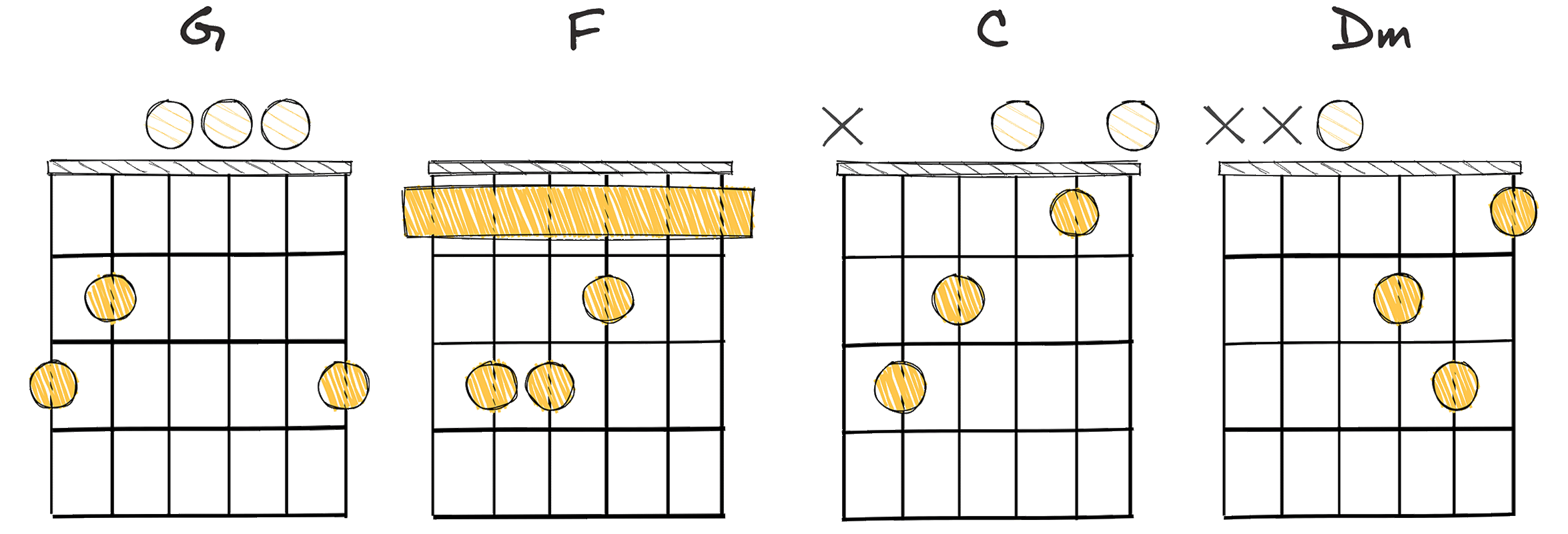
The 16th section chord blocks an interesting progression of chords labeled as V – IV – I – ii, in the key of C this will be G – F – C – Dm; this quite an characteristic chord sequence to dissect and understand.
Primarily, it’s crucial to grasp the concept that chord progression, in essence, is the foundation of any song.
Plenty of renowned songs from various genres often utilize this specific chord progression due to its simplicity yet dramatic emotional appeal.
Moreover, learning this chord progression aids in adding versatility to your musical pallet as it can be utilized in a wide array of genres spanning from blues, country, pop, and even rock.
The touch of simplicity in this progression offers endless opportunities to explore and experiment with unique strumming patterns or even finger picking routines, which is another reason why this progression is beginner friendly.
Beyond the technical standpoint, practicing this progression can also aid in developing an essential aspect for any musician, which is the understanding of how varying chords interact and correspond with each other.
Furthermore, although the sequence of chords is easy to play, it still demands precise finger positioning and a consistent strumming technique for achieving a seamless and rhythmic guitar play.
The learning curve for most beginners when engaging with this progression tends to be quite expedited given the simplicity and familiarity of the chords involved.
It is meritorious to note that versatility of the chord progression, V – IV – I – ii, is what gives it its timeless appeal and widespread application.
ii – IV – V – I (2-4-5-1)
A foundational progression, perfect for starting your guitar journey.
The ii-IV-V-I progression is a simple, yet versatile sequence that is a great starting point for any beginner guitarist. It provides a solid foundation for understanding basic chord relationships and transitions, and can be used in many styles of music, ranging from pop and rock to jazz and country.
- Example: Dm – F – G – C (Key of C)
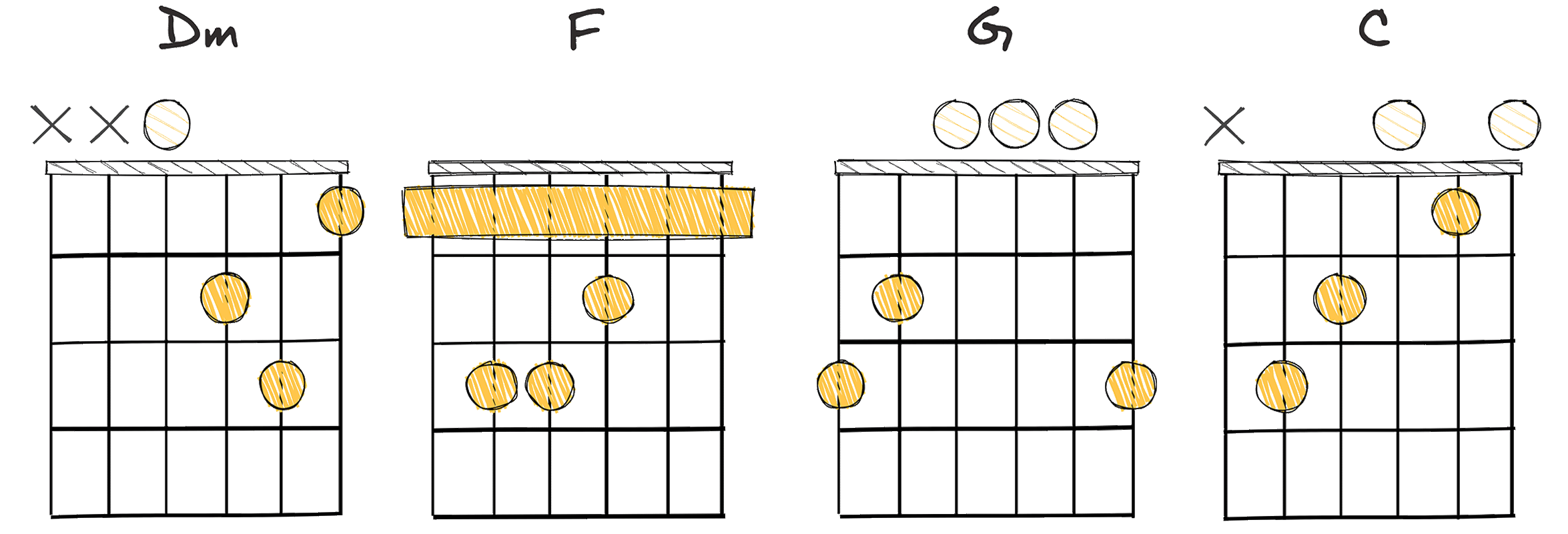
The chord progression ii – IV – V – I (2-4-5-1), also known as the 2-5-1 progression, is a fundamental building block in many genres of music, particularly in jazz.
It is essential for any beginner guitarist due to its simplicity and widespread use in popular music.
Bearing the key of C in mind, this progression ladders Dm (the ii chord), F (the IV chord), G (the V chord), and C (the I chord).
More than being easy to play, this progression is highly versatile, providing a solid foundation for creating countless tunes.
This progression is an ideal learning tool for beginner guitarists because it allows them to understand better chord relationships.
Such a statement stands because, upon learning and mastering it, neophyte strummers gain insights into the way chords interact with each other melodic-wise, offering numerous opportunities for self-expression.
It also serves to tune their ears into common chord sequences frequently employed in music.
The ii – IV – V – I progression has a rich history, used across diverse styles such as pop, rock, blues, jazz, and classical music, each of which had adapted and played around with it to fit specific musical contexts.
It’s been highly favored and continually employed since its introduction due to its inherent musicality and the pleasing tension and resolution it provides.
Serving as the cornerstone of many timeless hits, its importance in our musical history cannot be overlooked.
This is the reason why it’s a must-learn for anyone aspiring to master the guitar; knowledge of this progression provides them with a solid basis from which they can start exploring more complex chords and progressions.
Yet, while it is simple to play, mastering the ii – IV – V – I progression requires time and practice.
Like any musical ability, precision comes only with consistent practice and understanding its theory and application.
In doing so, beginner guitarists can ensure a smooth musical journey, armed with a fundamental chord progression that will aid them as they delve deeper into the art of guitar playing.
Thereby proving that the ii – IV – V – I chord progression is not just a piece of musical history, but a significant and valuable tool for musical growth and creativity.
The Bottom Line
Studying these chord progressions – I – IV – V (1-4-5), I – V – vi – IV (1-5-6-4), ii – V – I (2-5-1), etc.
– represents dipping into the timeless well of musical tradition.
These sequences found ubiquity for a reason – they offer a pleasing and satisfying assortment of sounds to human ears.
These common progressions experienced in various genres help bind music together, creating shared thematic threads across diverse compositions.
They reflect not just a history of music but the commonality of human emotional expression.
Therefore, understanding and utilizing such progressions is pivotal for anyone aiming to excel in the field of music.
Ultimately, they are fundamental patterns that constitute the basic building blocks of music and are indispensable tools for musicians.
In love with guitars, and gear; expert in all things music! Been writing about guitars for about 5 years and counting. Born in the ’90s. Alma Mater: University of Havana. Always curious, trying to understand the world. #TeamFender




